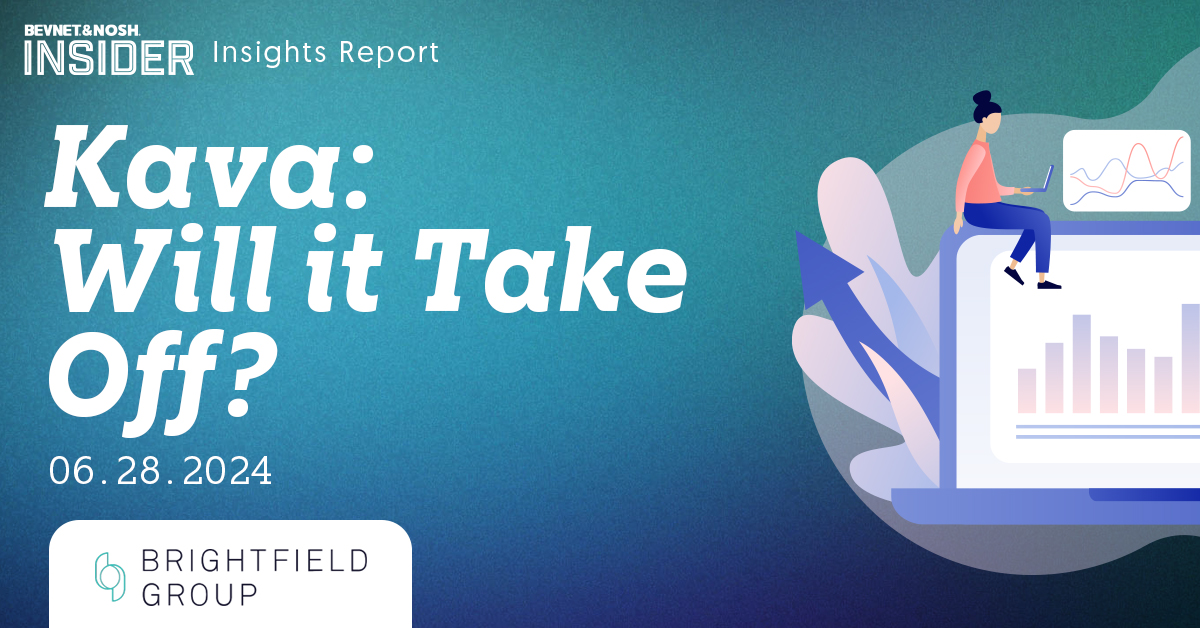This is the first post of our exclusive food and beverage industry data series crafted just for our BevNET & Nosh Insiders! This report is in partnership with Brightfield Group, a renowned name in industry data and insights.
Please note that below is a shortened version of the report. View the full version here.
Kava: Will It Take Off?
Kava first caught Brightfield Group’s attention in 2021 when we started to see conversations about the ingredient growing in
social listening. From there, we looked at our consumer survey data and saw our most innovative segment, the Trendy
Enthusiasts, also increasing adoption of Kava. Google Trends showed tentative validation in late 2023. Brightfield also has confirmed an increase in sales (albeit slow) among point-of-sale data partners.
Current Kava Consumers & Category Outlook
Kava Purchasers are mostly male, Millennials who are Trendy Enthusiasts and Wellness Seekers. The big question behind the Kava opportunity will be whether Kava can move past this emerging phase with Trendy Enthusiasts and Wellness Seekers and expand to more mainstream segments. Despite the increasing usage and sales, social engagement around kava seems to be declining. This discrepancy suggests that kava lacks a clear market position or product category, which is crucial for broader adoption. To reach a wider audience, kava needs to define its niche more clearly.
What’s Behind the Kava Conversation?
Exploring the social conversations about Kava can provide context and uncover opportunities to better define the category. Kava bars are becoming quite popular across the country, and many consumers share their experiences online. Interestingly, kratom is often mentioned alongside kava in these posts. Despite being distinct substances—kratom being an opiate and kava a relaxing herb—consumers frequently equate the two. Additionally, kava is often discussed in the context of anxiety and sleep difficulties, highlighting its potential benefits in these areas. These conversations indicate an opportunity for Kava to better attract the overall relaxation consumer and lean into this positioning.
Kava Purchasers are Stressed and are turning to substances for relief
Kava purchasers frequently explore multiple avenues for relaxation and stress relief, associating kava with substances such as cannabis, tobacco, alcohol, CBD, hemp-derived THC, psilocybin, and kratom. This indicates a significant opportunity to position kava more effectively within the relaxation need state and expand beyond it. Additionally, 75% of kava purchasers report consuming less alcohol compared to 58% of the general population, highlighting kava as a potential substitute for alcohol. With 27% of kava users experiencing high levels of stress due to issues like sleep disorders, weight concerns, and mental health conditions, positioning kava as a solution for stress, anxiety, and sleep could drive its appeal.
Continuing the Kava Exploration
How can brands better understand the Kava opportunity? It will be crucial for those tracking Kava to understand both the consumers and the conversations behind this trend. Brightfield Group will be monitoring not only the category’s growth but also whether the consumer profile expands to more mainstream audiences and how the social conversations change over time to help predict the trend’s momentum. By strategically aligning with these relaxation and stress-relief needs, kava brands can not only capture a larger market share but also foster a loyal community of consumers seeking natural alternatives for well-being.
About Brightfield Group
Brightfield Group’s AI-driven consumer insights and social listening help marketing and innovation teams see the person behind the trend. Informed by predictive AI integrated with survey and social media data, Brightfield Group provides the answers innovators need to make decisions confidently.
